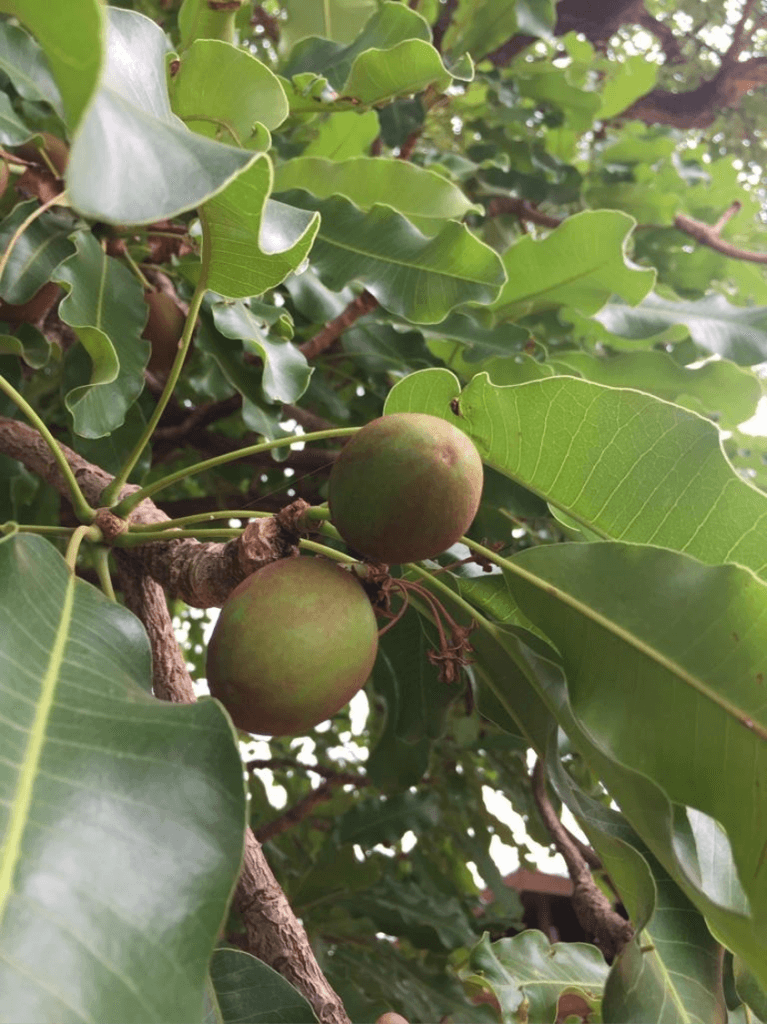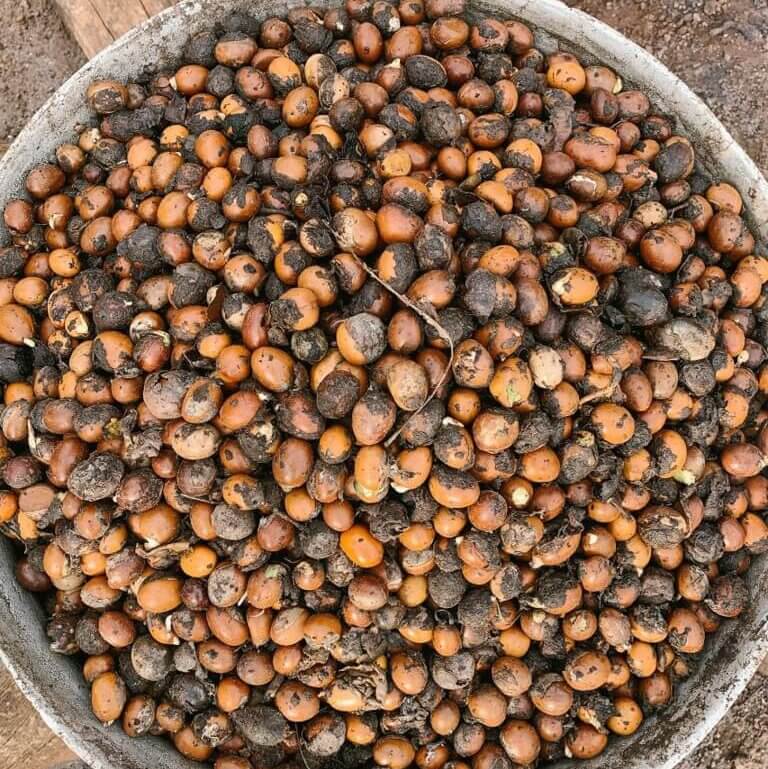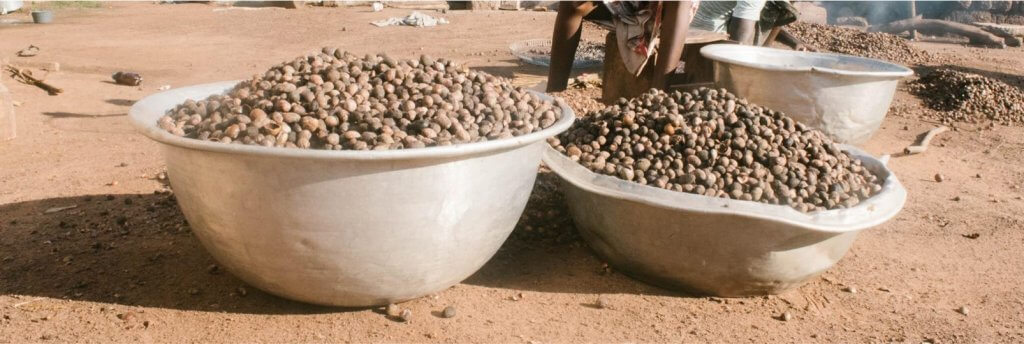Livelihoods is launching a sustainable shea sourcing project in Ghana to bring support to 13,000 women farmers
When we talk about “shea” or “shea butter” in Western countries, we mostly think about a natural product with highly nutritional and moisturizing properties. A product increasingly used in the food and cosmetics industries and whose market is booming. In the past twenty years, the global shea industry has grown by 600%[1]. But in Sahelian Africa, where shea trees exclusively grow, shea is much more than that: it is a source of income for 16 million of women who harvest millions of shea kernels every year.
In the vast northern Ghana, fourth largest shea kernel producing country in the world, shea is an economic opportunity for 470, 000 women farmers. But the challenges they need to face are many: in this poorest region of the country, scarce rainfall has led to poor land, unpredictable yields, and food insecurity. With little knowledge of the international shea market demands, women often trade low value shea kernels locally. Plus, shea being a seasonal work, the income they get often arrives too late to support them in their family and farming activities.
How to ensure a responsible supply of high-quality shea in a context of growing market demand? How to help the women of shea gain more from the kernels they harvest? How to boost other economic opportunities for them when shea is a seasonal activity?
The Livelihoods Fund for Family Farming (L3F) is taking up the challenge by launching a 10-year program that brings together a coalition of major players in the shea value chain: Mars Incorporated (a global business that produces some of the world’s most famous brands of confectionery, food, and petcare products and services) AAK (the world’s leading provider of value-adding plant-based oils and fats, and Mars’ supplier of shea), USAID (the U.S. Agency for International Development and co-funder of the project), CARE (a global humanitarian organization working for the social and economic development of shea women collectors in Ghana and implementing partner for USAID), and local NGO Presbytarian Agricultural Services (PAS) which has been working closely with rural and farming communities in Ghana for 50 years.
The project, called “the Women in Shea Initiative” aims at building a responsible shea supply chain in East Gonja District, Northern Ghana, by providing 13,000 women farmers with sustainable income, diversified agricultural production and preservation of the shea natural ecosystem in a particularly arid area.
The shea tree: a source of income for 16 million of women in arid, Sahelian Africa
The shea tree is a fruit tree that grows naturally in the wild, in the dry Savannah belt, also known as the “shea belt” which stretches from Senegal in West Africa to Sudan in the east, and on to the foothills of the Ethiopian highlands. Quite surprisingly, it has never grown in other parts of the world, and it occurs in 21 countries across the African continent[2],including Ghana, whose northern region falls into the “shea belt’. Shea is known as an ancient tree that has been used for thousands of years by the women in the region, for its health, wellness, and nutritional properties.
The development cycle of a shea tree is particularly long, as it starts to bear fruits only at 15 to 20 years of age. As the trees start to reach maturity at the age of 45, the production of kernels increases at the same age, until age 100 to 200 before it slowly declines.
Shea trees are mostly found in agroforestry systems, called parklands: these are landscapes where trees are left to grow, in cultivated and fallow fields. Agroforestry parklands are the most common farming system in this particularly arid region, and they occupy over a million square kilometers in an area that is home to 112 million people. But shea trees are also available in the surrounding forests, which are more difficult and dangerous for the women to access.
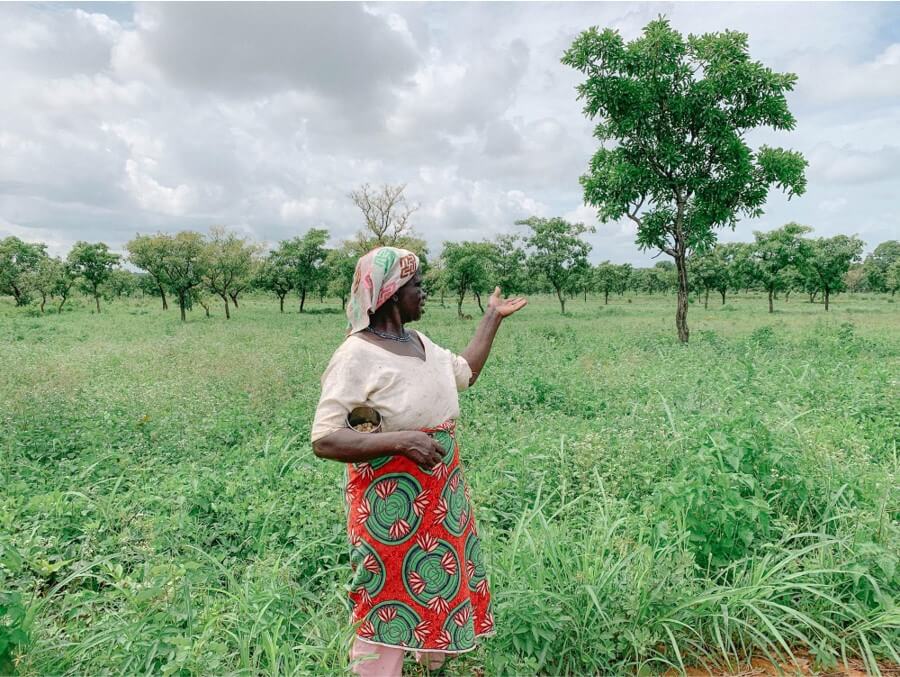
Shea trees are harvested during three to four months, once a year, from May to August, which is the rainy season. When the kernels get ripe, they turn brown and fall to the ground. The women collect the kernels from the ground, within the shea parklands or further away, in the forests to collect larger quantities of kernels.
In Ghana, the yearly average of shea kernels production is 94,000 metric tons, making it one of the largest producing countries in the world. In total, 470, 000 women are involved in shea nut collecting in Ghana: upon harvest, they sort, dry, parboil, stock and sale the kernels to local markets or customers, in exchange of an income that contributes to provide for their families food needs, children education or medical fees. Very often, the income they gain from shea kernels sales also contributes to the community’s essential needs. But shea production is cyclical, with two good harvests followed by a bad one. While it contributes to 30 to 40% of the women’s revenues, this makes it an unpredictable source of income.
A booming international demand for shea in the cosmetics, food, and medicinal industries
Even though almost all parts of the shea tree (its leaves, bark, roots…) can be used for different purposes, its fruits and shea kernels are the most economically important ones. Looking like green olives, shea fruits have a light green outer skin, which protect a fleshy pulp that is edible and sweet. Inside it, there is a shell that contains the shea nut, which in turn contains a fatty kernel.
Throughout Western and Central African countries, kernels are also extensively used for food as a dietary fat, but also for medicinal purposes as a natural moisturizer during the dry season, and for the skincare of young children. But even though shea has been known in Sahelian Africa for thousands of years, the international demand has grown drastically in the past two decades: volumes of shea kernels exported have increased from 50, 000 to more than 300, 000 tons[3] during this period. And the industry is still expected to grow by 50% by 2025.
In Western countries, 90% of the exported shea kernels from Sahelian Africa are processed in the food industry. Shea kernels are processed to produce vegetable fat that is used in the manufacturing of chocolate and other confectionary products. The remaining 10% of exported volumes of shea kernels are used in the cosmetics industry, where shea butter is prized for its highly moisturizing qualities and used in products for skincare or hair care for example.
To the women farmers in Northern Ghana, shea is a hard but necessary work to step out of poverty
Northern Ghana is a rural and arid area where farming and wood collecting is the main livelihood for the women of shea. This is their main activity most of the year, but their everyday duties also include taking care of their household, children education and health, cooking and cleaning.
While men’s main occupation is farming, in Northern Ghana, shea is an activity exclusively led by women. It is a source of income the whole household relies on, to provide for their basic needs. Women usually control the upstream part of the value chain, from collection of kernels to processing. But women consider themselves as farmers first, and shea is a side activity which occurs during the rainy season, from May to August. The shea trees are most often available on their husbands’ farms, or other family members farms but also further away into the forests and bushes, which are more difficult to access.
STEP 1: COLLECTING THE KERNELS
The first step of the shea value chain starts with the shea kernels collection, which, when mature enough, have fallen on the ground. Women start very early in the morning, so that they can cope with their usual family and farming duties. They trek to reach parklands located 5 to 10 kilometers away from their homes. Having no transport means, they must carry up to 30 kilos of shea kernels on their head, to reach back home for food processing.
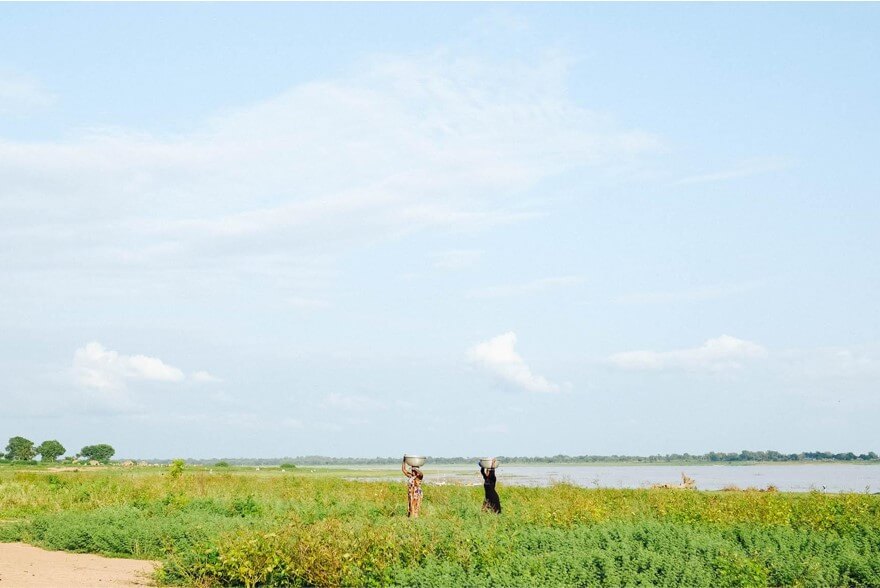
STEP 2: PARBOILING THE KERNELS
The second step consists in parboiling the kernels to keep them from germinating. They use a large pot over a traditional three-stone stove which consumes significant quantities of wood and water. In Northern Ghana, traditional processing of kernels into 1kg of shea butter requires 9 liters of water and 3.3 kilos of wood.
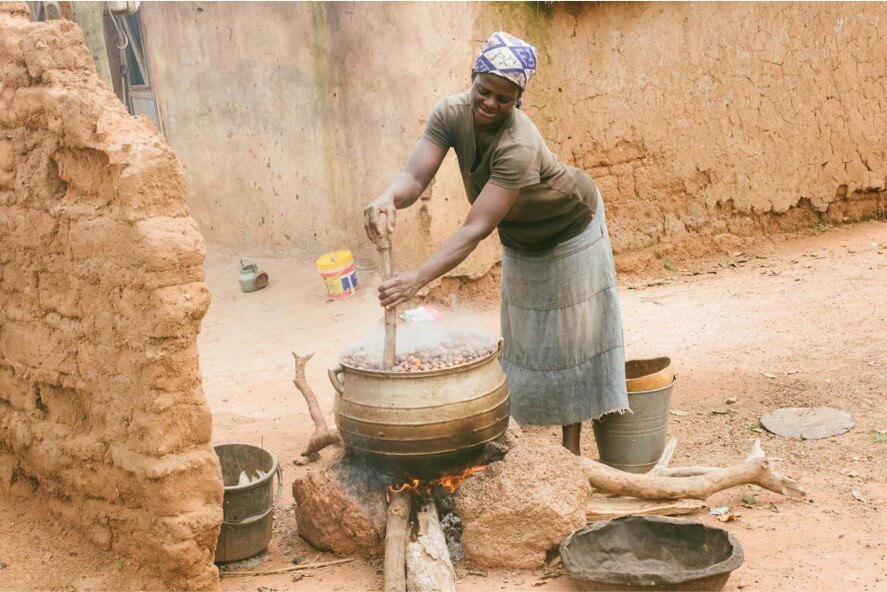
STEP 3: DRYING THE KERNELS
Third, they must dry their wet shea kernels, so that they do not turn black or moldy. Shea is poured on the ground of their homes compound, and if they need more space, they lay them out outside. But the rainy season comes up with a challenge: it can therefore take weeks for the kernels to get sufficiently dry.
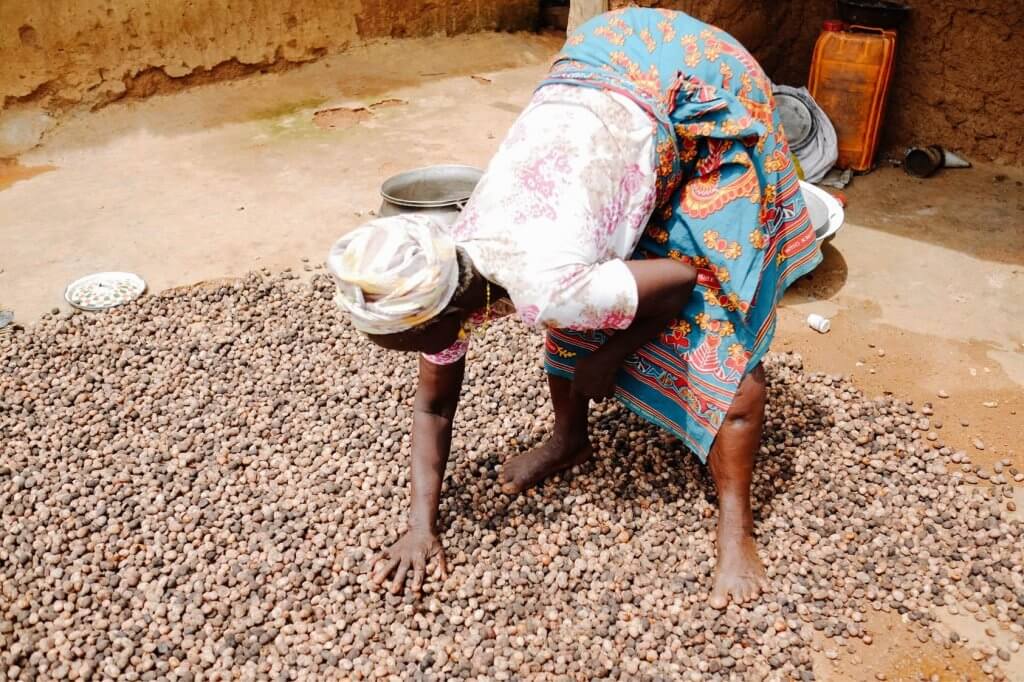
STEP 4: DE-HUSKING
Then, comes the de-husking step: women de-husk the kernels by using a wooden stick to break off every piece of the outer shell. They sift the shells out by pouring the kernels from bowl to bowl, letting gravity remove the shells. De-husking is a tiring but social activity.
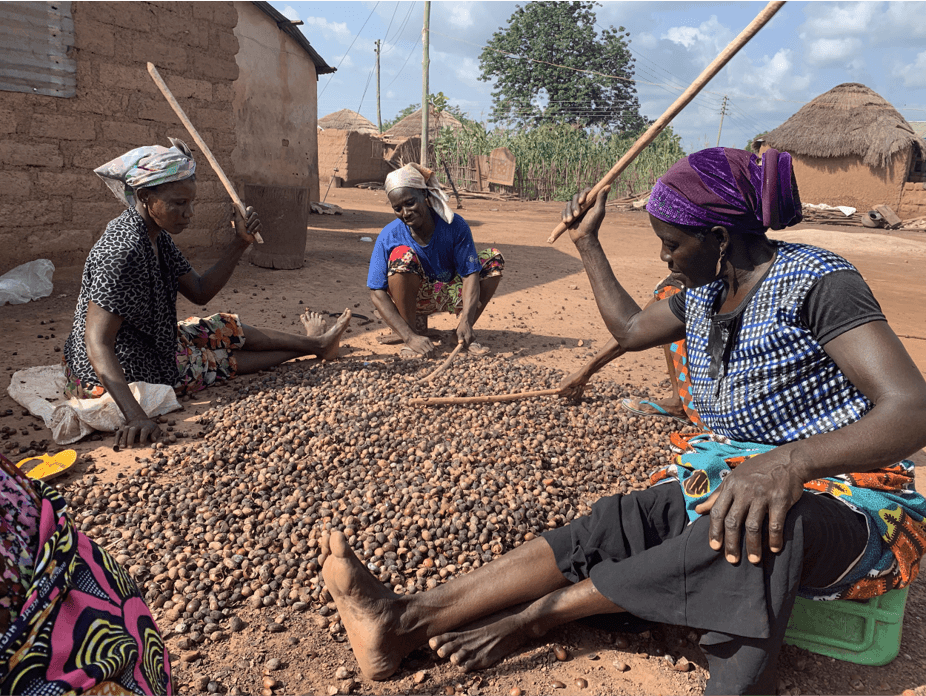
STEP 5: STORING
Once their shea kernels are dry enough, women usually store them in their homes, along with other goods from the farm. But moisture can get in the bags as they are stored on the floor or against the walls, thus affecting the kernels quality.
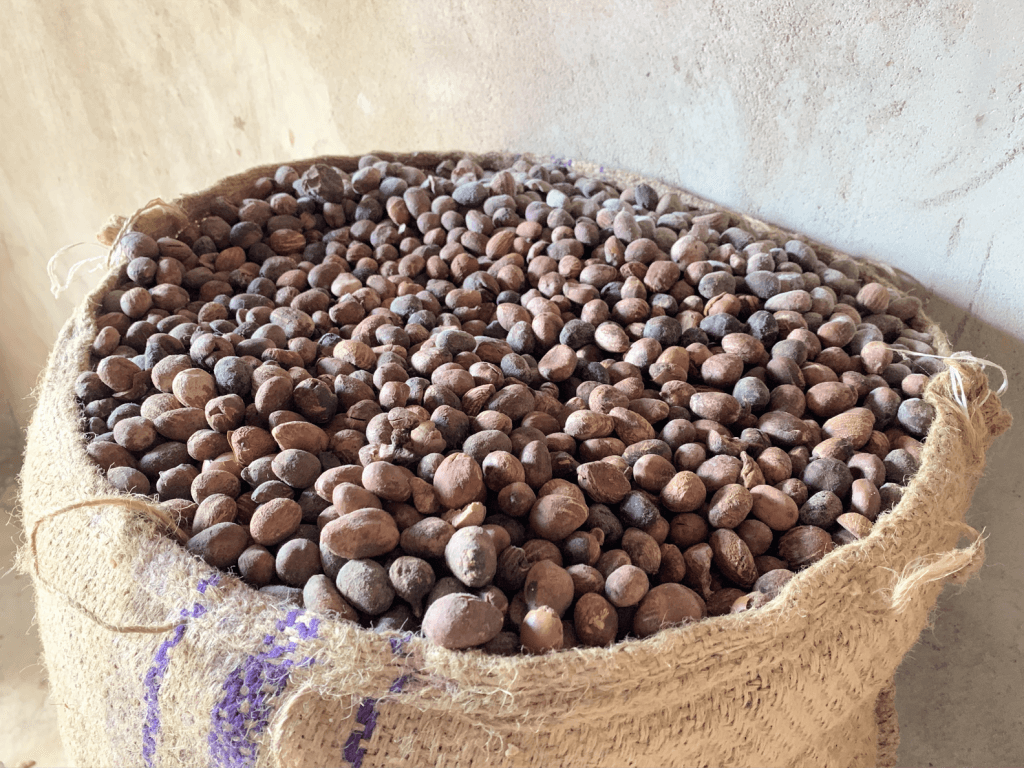
STEP 6: SELLING THE KERNELS TO LOCAL BUYERS
Finally, women sell their bags of kernels to local buyers (middlemen and market women) including to AAK officers who pre-finance to support the women’s financial needs. AAK, the world’s leading provider of value-adding plant-based oils and fats, has been particularly active in the region to boost sustainable sourcing of shea. Launched in 2009 in Burkina Faso and later on in Ghana, its program called “Kolo Nafaso” (“the house of benefits of shea kernels”), is supporting women to gain a fair price with no intermediaries as well as provide them with pre-financing before the shea season starts to help them gain sustainable income during the lean season. To this day, this initiative has already reached more than 300,000 women beneficiaries overall across four countries.
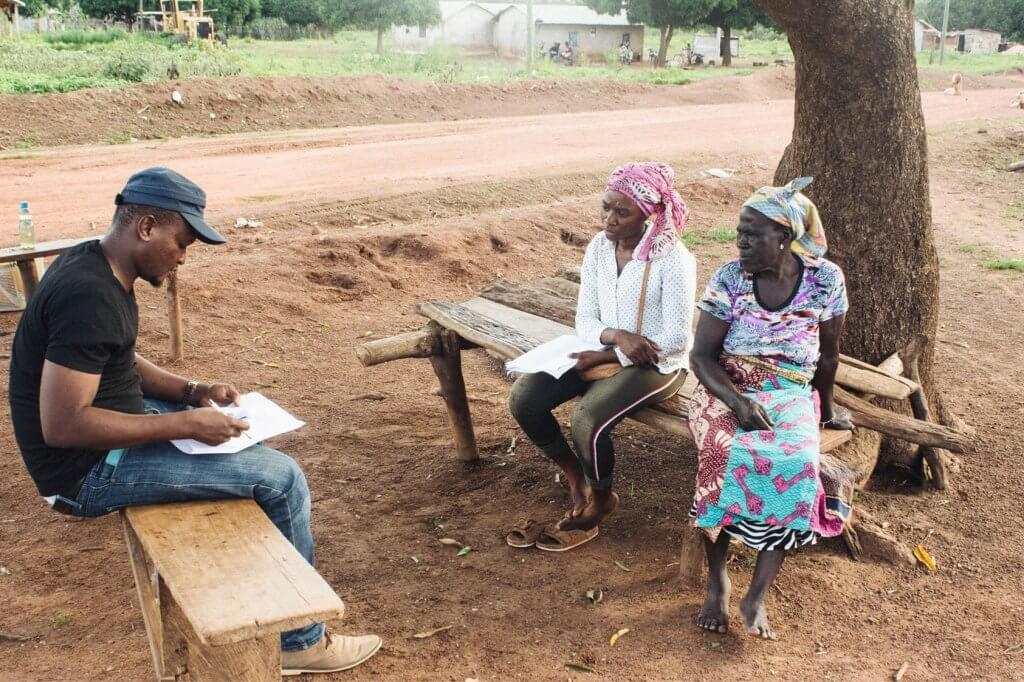
Livelihoods project in Northern Ghana: building a responsible shea supply chain to improve the livelihoods of 13,000 women
Together with Mars, AAK, USAID, CARE and the local Presbytarian Agricultural Services NGO, the Livelihoods Fund for Family Farming (L3F) is launching a large-scale responsible sourcing project to bring more economic benefits to 13,000 women in Northern Ghana. This program called the “Women in Shea initiative” will build upon AAK’s existing responsible sourcing program, Kolo Nafaso, and will focus on the following main pillars:
Improve shea production efficiency and product quality to increase income for women farmers:
First, provide the tools, trainings, and support necessary to help them increase the quantity of shea kernels they collect as well as their quality, to improve their income. For example, new transport means will help them carry more kernels during the collection process, save time and reduce the burden of carrying the kernels. Equipping the women with efficient cookstoves will help them reduce exposure to toxic smokes when they will need to parboil the kernels, as well as significant wood and water consumption. Simple tools and methods such as lifting the nut bags by using drying beds, will reduce the risks of moisture and therefore increase the shea kernels quality.
Support the women to identify, produce crops and create new sources of income to complement shea production:
Second, the Women in Shea Initiative will support the women’s farming activities during the dry season, to provide them with a diversified source of income. Trainings on sustainable agricultural practices that will help regenerate the soil in a particularly arid land will help them increase yields whereas providing them with seedlings (improved cereal seeds, inoculants, and tree seeds…), will help increase their food security and create sales opportunities in new markets.
Improve natural resource management and governance for sustainable shea parklands:
Parklands across Sahel-Savannah eco-zones are significantly threatened by invasive land use. Shea trees are frequently used for firewood and charcoal. However, without fallows for regeneration, the decline in shea trees is now a major threat to the parklands sustainability. The project will build a sustainable model for parkland management with 10 communities to demonstrate that parkland protection can be reconciliated with farming activities and improved livelihoods. Project activities include beekeeping, assisted natural regeneration, and increasing the density of trees in the parklands, moving from 18 to 50 trees per hectare to increase the quantities of kernels to harvest.
Improve access to financial products and services to help women grow their businesses:
The project activities also include organizing women into small groups of 25 to 30 to enhance their commitment to the program, facilitate knowledge sharing on shea activities but also on farming activities. These groups will help promote microfinance services thanks to which the women will access savings and small credits to help them boost their financial activities. This model will provide women with the means to cope with financial emergencies as well as re-create social dynamics.
Learn more about the coalition of private & public partners around the project.
[1] According to a study by FAO & data from the Global Shea Alliance, published in July 2020.
[2] Namely Benin, Burkina Faso, Cameroon, Central African Republic, Chad, Ethiopia, Eritrea, Ghana, Guinea Bissau, Ivory Coast, Mali, Niger, Nigeria, Senegal, Sierra Leone, South Sudan, Sudan, Togo, Uganda, Democratic Republic of the Congo, Kenya, and Guinea.
[3] According to a study by the Global Shea Alliance published in 2017.



